
The night was pretty cold. Cold enough to make us cover our heads from the wind. The wind was strong enough to tear the canopy off of Dan's truck, but it was not damaged. For breakfast, we had bacon and eggs with fried potatoes that were made from the excess baked potatoes from the night before. We broke camp and Kathleen decided she was going to ride the Banshee. Once we were ready to go Dan and Kai headed up the south face of the star dune with the cross and descended down the soft south face. Below, you can see the soft sand flow once it is perturbed by tires. Most of the dunes in the area are at the maximum angle of repose, so any disturbance will cause the sand to flow. Note the "bow wave" of sand in front of his tires on the descent.

As I mentioned earlier, the area around the cross is heavily traveled. As a consequence of being heavily traveled and being Mexico, there is substantial trash that has been discarded by the visitors. Since the last visit to this area, one of the 4x4 clubs has erected a sign that is telling the locals not to throw trash. As a side note, we packed it in and packed it out. Every night, we burned the trash from the current day and re-burned the previous day's load. The result was that the whole week's trash fit in one black bag. This is in great contrast to the behavior of the locals as we will see in later photos.

The Altar is an ocean of sand. The dunes run for several hundred miles with high razor back dunes interspersed with open tundra with vegetation. Below, you can see the classic S shaped razor back dunes that result from bi-directional winds.

As the second day wore on, we got deeper and deeper into the dunes. Below, you can see the scope of the sand relative to the 1300 and Kathleen on the quad.

We took a break to assess the situation and look at the scenery. The mountain range on the right side of the photo is the Tinajas Altas range in southern Arizona.

Another classic razor back dune.

Our good luck in travel did not last long. Below, I am assessing the punishment the Altar can deliver. What you cannot see clearly from this photo is that the tire was turned inside out and required much work to get oriented correctly.

Even after getting the tire in the correct orientation, it was still a bitch. It got the "ether treatment" several times and still required a large ratchet strap, the hammer and lots of elbow grease to get the bead to re-seat. The right rear tire was the problem child of the trip; it lost bead perhaps 10 times total. Some were over night, some during travel. But one thing for sure, you will crack a sweat getting it back on.

Once we got rolling again, the dunes got bigger and softer. The dark spot in the photo below is the 1300 with the photo being taken by Matt from the 416. These dunes are huge.
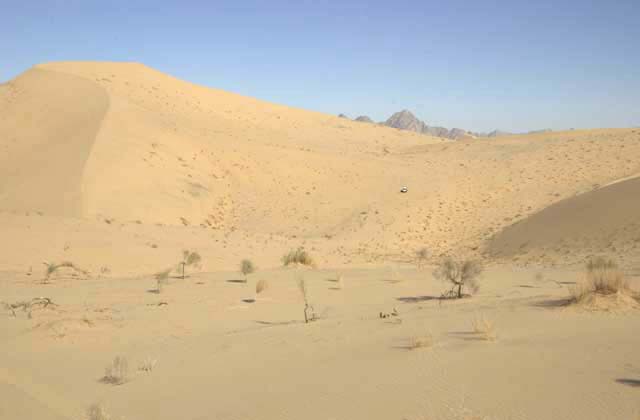
Later in the day, we managed to work our way to the top of one of the bigger dunes. Below, you can see the trucks with the small spots being the team on the edge of the dune.
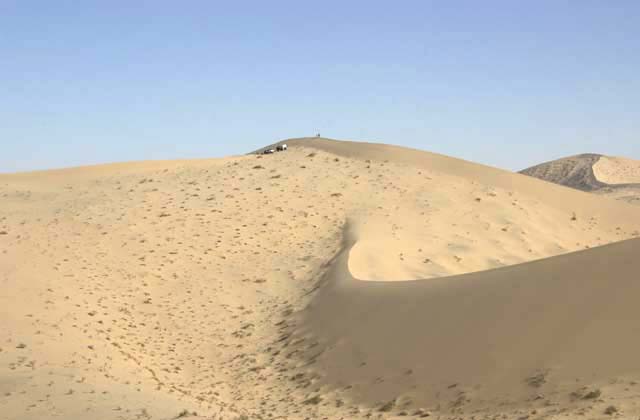
Here is a view of the team on the same ridge. The sand is very soft and very steep; again at the maximum angle of repose which for this coarseness of sand is about 45 degrees. You can tell the softness by the "slurring" of the footprints as the team attempted to make it up the ridge. Also note Nancy on the right being forced to support herself with their hands due to slippage.
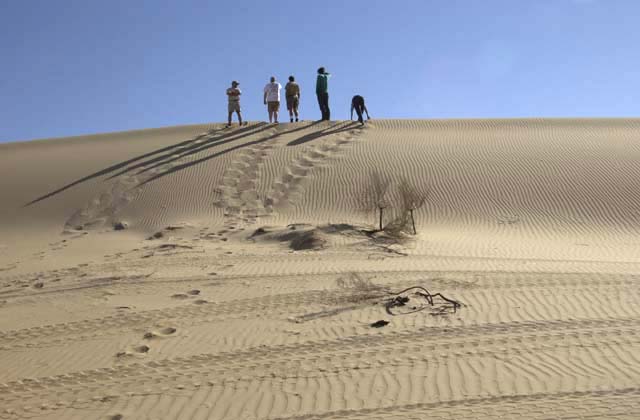
The track of the 1300 with those Terra Tires is about 9 feet. It side-hills great.
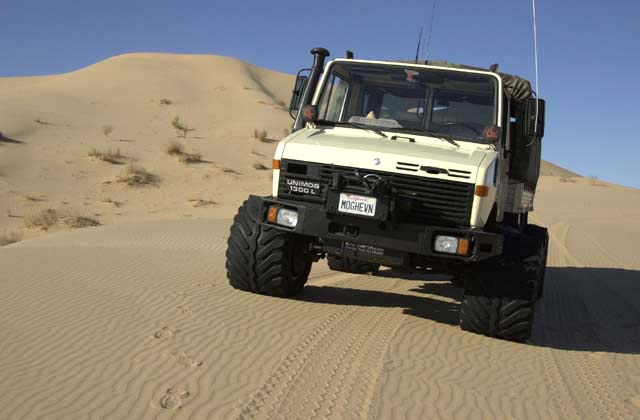
Some of the faces of the dunes are truly daunting. You can see the sand flows as vertical lines in the photo below. The steepness makes descending the faces very scary and dangerous.

Shot from the cab of the 1300, you can get a feel for the steepness of the descent. This was a huge face; a sphincter tightening descent as the truck will slip to the side. Additionally, the remedy for that side slip is to point it downhill and hit the accelerator. Speeding the descent was not what I wanted. Also, in the steep sand, the front tires will submarine when you hit the brakes, thereby causing you to lose all steering capability.
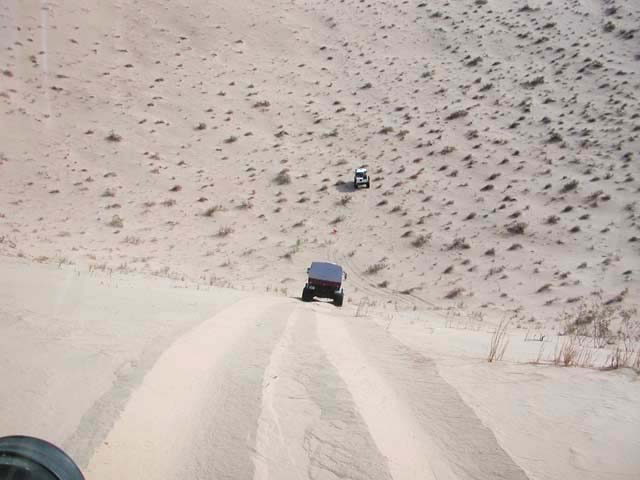
The Altar Dunes are part of a Mexican National Park and the so-called Biosphere. This trip we saw many more signs of wild life than the last time. There were tracks everywhere. Below is a sand gecko, one of the types of lizards that live in the sand. Note that the color of the scales are very close to the color of the sand. These lizards haul ass when disturbed, and they are faster than the quad. If you get too close to them, they bury themselves in the sand with a alligator-like swimming motion and then they are gone for good.
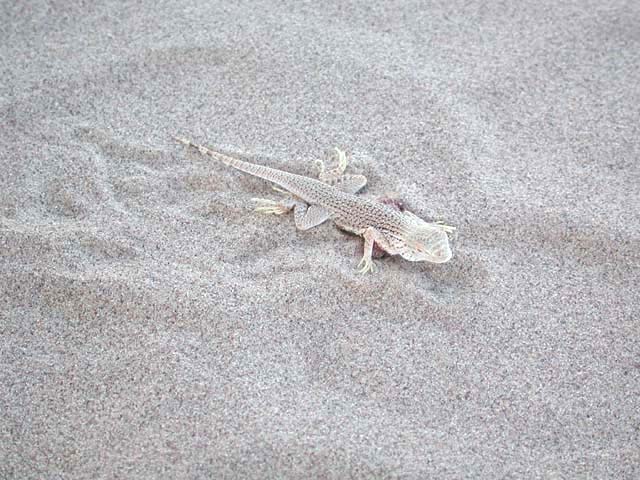
Not all creatures in the desert are benign. Below is a shot of an unwelcome visitor that Kai just happened to see next to his tire after we made camp. Like the gecko, the color of the scales helps hide them from predators. These rattlesnakes are venomous and are quite dangerous. While this one was less than a foot long, the venom is a hemolytic enzyme that digests mammalian tissue and will ruin your day if you get bitten. Make no mistake about it, these sidewinders are fast and very agile in the sand. They use their patented motion to rapidly negotiate steep dune faces and you can see their tracks in the sand in the morning.
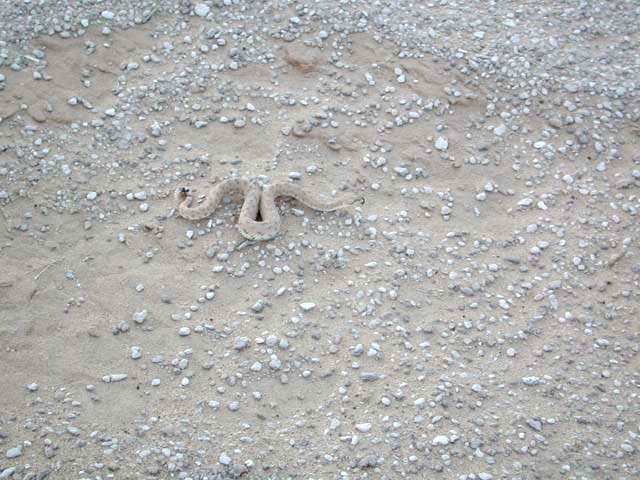
Despite the presence of the sidewinder, for reasons that I cannot fully articulate at this time, we slept on the ground anyway. As we did for ever camp during the expedition. Camp Sidewinder was a good camp with good food. Kathleen made chicken enchiladas in the Dutch oven and we chased it with a ton of liquor and red wine. As always, we had a nice fire thanks to the large amount of hard wood that Dan brought with him. Then we went to sleep with the sidewinders.